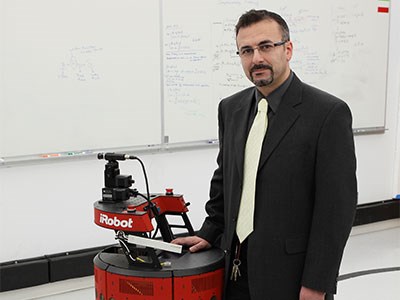Abdelhamid Tayebi is the first to admit he’s no authority on fighting forest fires. But when it was suggested the Lakehead University professor’s research into autopilot technology could be used to guide unmanned aerial vehicles (UAVs) into inhospitable places—such as forest fires—his phone started ringing off the hook.
“I became the expert in firefighting, which I am not,” Tayebi chuckled. But he is an expert in autopilot technology. Tayebi, an electrical engineering professor at the Thunder Bay school, is currently designing efficient and smart pilots, or the brains, used to levitate and land UAVs.
His expertise is being recognized by the Natural Sciences and Engineering Research Council of Canada (NSERC), which is granting him $345,000 to continue his research. The funding will allow him to recruit high- level graduate students and post-doctoral fellows to participate in his research program.
Autopilot technology isn’t new—the first autopilot was developed in 1905, Tayebi said—but the technology has been rapidly progressing since then.
“It was really basic back then in 1905,” he said. “Basically, the pilot had to help the autopilot—it wasn’t fully autonomous, but it was doing its job for what it was wanted to do. But today we’re looking for more autonomous UAVs.”
The most basic task for the autopilot is balancing the UAV, or maintaining its stability in the air, something Tayebi compares to balancing a broom on your finger. That task alone carries with it technical challenges. But an autopilot also needs to provide GPS-based navigation, which allows a UAV to follow a route while avoiding obstacles, as well as the motion coordination of multiple UAVs, which would allow for multiple aircraft to fly in formation, while maintaining distance between them.
UAV technology has progressed to the point where, today, Tayebi can send a UAV through his office to retrieve documents, but the UAV still requires permanent supervision. He compares it to a pilot flying a plane: the pilot can use autopilot for some of the tasks, but ultimately must be present in case anything goes wrong.
The goal is to develop a UAV that is fully autonomous.
“I design the autopilots and then you can imagine all kinds of applications,” Tayebi said. “This can be used in surveillance applications, military applications and civil applications also—the inspection, maintenance of power lines, for example, or the inspection of monuments, bridges and buildings.” Detecting forest fires is one purpose Tayebi concedes he hadn’t considered, but he doesn’t discount it. UAVs could be deployed in strategic locations in the forest and used as a network of mobile sensors, which could communicate between each other and relay information to a ground station, he said.
As long as the autopilots are working well, engineers can program them to perform those specific tasks. Yet, even if the technology could be used for firefighting, other obstacles stand in its way.
According to Transport Canada regulations, the use of fully autonomous UAVs is limited to military applications. Anyone operating a UAV must keep the vehicle within visual range, primarily to avoid collisions with other aircraft.
Anyone wishing to operate a UAV in Canada must apply to Transport Canada for a special operating licence giving them permission to do so.




